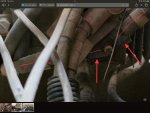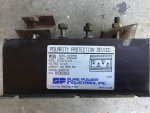What NDT said. under the power panel cover in the cab y0u will find 3 round power/test points on the left. 24v, 12v and ground. What do you measure between the 12 and 24 points and the ground point in the cab, and what do they measure when you turn on the ign switch?
RULE 1: VOLTAGE IS NOT GOOD UNLESS TESTED GOOD UNDER LOAD! Like a kink in a garden hose, a bad connection will pass full voltage(pressure) throughout a circuit UNTILL you try and flow current thru it then the voltage will drop off drastically
I doubt you fried anything as they put a diode polarity protection device(PPD) inline between batteries and cab. A diode, like a check valve only lets current flow one way… it is located between the spare tire and the air filter can. It is easiest to access by lowering the spare tire.
What I suspect you are experiencing is a bad connection that won’t pass current when the switch is flipped… but we can confirm the wires are right also…
They ran a 24v line direct from battery to starter solenoid To carry the high current the starter demands.
They ran a second 24v line from battery to 24v batt terminal on the PPD
They ran a 12v line from middle of 24v series batteries to the 12v batt terminal on the PPD.
The alternator 12 and 24v lines run to the PPD batt terminals also
The 12 and 24v load terminals on the PPD run direct to those 12 and 24v test points in the cab power panel…
Battery ground runs from the batteries to the front end of the starter motor housing via a device called a “Shunt” located near/below the PPD. A shunt is a device to measure electrical current through a circuit. It is part of the mostly useless STE system(standardized test equipment) they put on the A0 trucks.
from the front of the starter motor where battery ground is connected, there is a ground strap that runs from the starter ground stud to the drivers frame rail.
THIS IS YOUR MAIN CHASSIS GROUND! There is another strap from alternator to passenger frame rail, and a third important one from front end of passenger frame up to the cab inside the engine hump/tunnel(remove grill to access). In general the grounds on these trucks are junk, they were done after paint and generally rely on a star washer penetrating the paint… they should all be disassembled sanded to bare metal for a good electrical contact with the attached strap and once re-assembles with the star washers in the trash where they belong, paint over the whole assembled connection(bare frame metal, clean bare metal ground strap terminal, lock washer and nut)…
and if you have a NATO power plug, it has a ground lead and 24v lead connected direct to the batteries.
Since the PPD and the Shunt are out in the weather, i suspect those connections are corroded and failing. This is perhaps the most common electrical failure on these trucks.
if you don't have 12 and 24 on the cab test points or it goes away when you turn on the main switch, I suspect you will find a bad power of ground connection at the PPD or shunt, or the batteries are failed, which can be confirmed by measuring battery voltage at the batteries with switch off and switch on
Good Luck!










